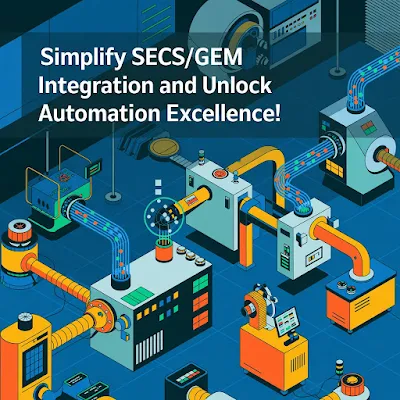In the rapidly advancing world of semiconductor manufacturing, efficient communication between equipment and host systems is critical. Standards like SECS/GEM (SEMI Equipment Communications Standard/Generic Equipment Model) enable streamlined interactions, ensuring consistency, compliance, and automation. Whether you are a facility engineer or a developer working on equipment integration, tools like a SECS/GEM simulator and SECS/GEM tester are indispensable for achieving seamless compliance and robust operations.
This guide delves into the importance of SECS/GEM simulation, its applications in compliance testing and equipment integration, and the tools that make it all possible. From the nuances of SECS/GEM communication to using advanced software tools, we’ll cover everything you need to master this technology.
Understanding SECS/GEM and Its Role
SECS/GEM is a standardized communication protocol widely adopted in semiconductor manufacturing. It facilitates communication between host systems (like MES—Manufacturing Execution Systems) and equipment, enabling real-time monitoring, data collection, and remote control. Tools such as SECS/GEM host simulators are used to replicate the host’s environment, aiding in testing and validating equipment compliance before deployment.
With increasing demands for automation and efficiency, SECS/GEM compliance testing has become a cornerstone for ensuring equipment interoperability. Whether it’s testing a new wafer handler or validating an etching tool, using a HSMS SECS/GEM simulator or similar tools ensures compliance with industry standards and minimizes downtime.
Key Tools for SECS/GEM Simulation and Testing
SECS/GEM Simulator
A SECS/GEM simulator replicates either the host system or equipment, creating a controlled environment for protocol testing. This allows engineers to validate the behavior of both equipment and the host interface, ensuring seamless communication.
SECS/GEM Tester
A SECS/GEM tester is critical for evaluating equipment’s compliance with SECS/GEM protocols. These tools check whether the equipment adheres to the expected communication patterns and ensures that it meets operational standards.
SECS/GEM Software Tools
Advanced SECS/GEM software tools simplify testing, debugging, and integration processes. These tools offer intuitive dashboards and automated testing features, enabling teams to quickly identify and resolve issues during development and deployment.
SECS/GEM Interface Simulator
The SECS/GEM interface simulator focuses on replicating the equipment’s interface, providing a robust platform for host systems to test their interactions with the equipment. It’s a vital component in achieving seamless integration.
Applications in Equipment Integration
Protocol Testing and Validation
Effective SECS/GEM protocol testing ensures that the equipment and host systems communicate reliably. This involves simulating various scenarios—from normal operations to error conditions—to validate the robustness of the implementation.
Communication and Data Exchange
A SECS/GEM communication simulator allows teams to evaluate how efficiently data flows between equipment and host systems. It ensures real-time data accuracy and reduces latency, which is crucial for high-volume manufacturing environments.
Equipment Simulation
Using a SECS/GEM equipment simulation, engineers can replicate the behavior of specific tools, allowing them to test host systems without requiring physical equipment. This reduces development costs and speeds up the integration process.
Best Practices for SECS/GEM Compliance Testing
- Use Realistic Scenarios: Simulate both ideal and challenging scenarios to ensure comprehensive testing of communication protocols.
- Leverage Advanced Tools: Invest in reliable tools like a HSMS SECS/GEM simulator and SECS/GEM tester to streamline the testing process.
- Focus on Interoperability: Test the integration across various systems to identify and address compatibility issues early.
- Automate Where Possible: Use automated testing features in SECS/GEM software tools to enhance efficiency and reduce manual errors.
Mastering SECS/GEM simulation is essential for semiconductor manufacturers looking to achieve seamless equipment integration and robust compliance. By utilizing tools like a SECS/GEM simulator, SECS/GEM tester, and other advanced solutions, teams can ensure their operations meet industry standards while minimizing risks.
Whether it’s SECS/GEM compliance testing, protocol validation, or equipment simulation, adopting these technologies will enhance productivity and operational reliability. As semiconductor manufacturing continues to evolve, mastering SECS/GEM simulation remains a critical step toward achieving excellence.
Are you ready to elevate your operations with SECS/GEM solutions? Explore advanced tools and resources to unlock the full potential of your manufacturing processes.


